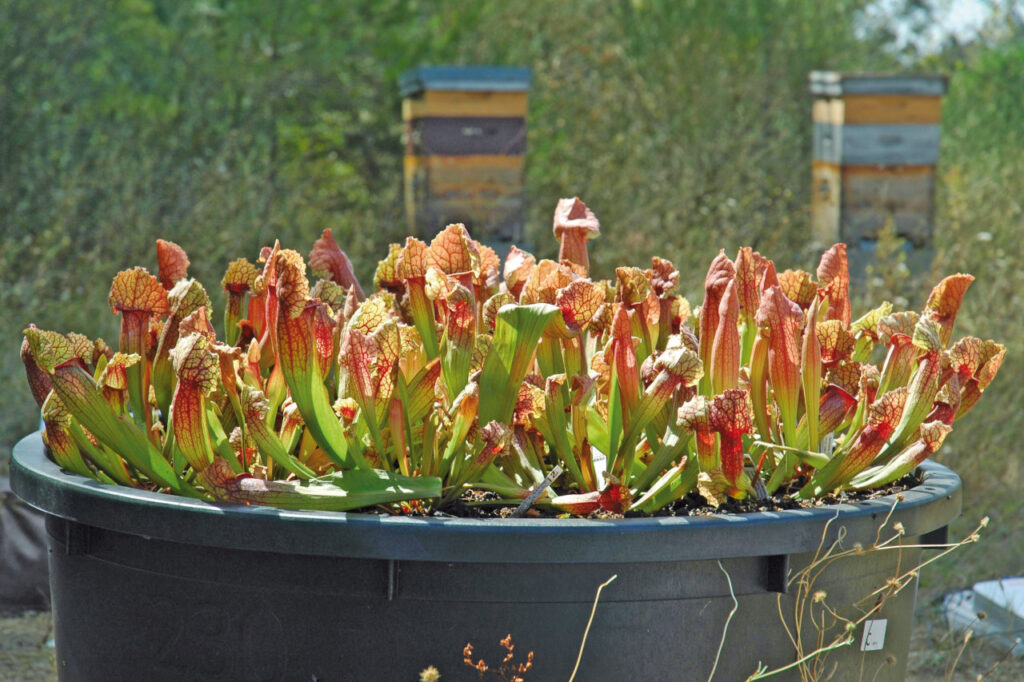[LUM#6] Asian hornet vs. carnivorous plant
The Asian hornet is invading France and Europe, threatening our already ailing bees. How can we stop it? Sarracenia, a carnivorous plant, knows how to attract and capture them... and offers an inspiring model for making an Asian hornet trap.

After pesticides and parasites, now comes the Asian hornet. This cousin of our European hornet, which arrived in France less than fifteen years ago, is wreaking havoc on bee colonies. Hovering in the air, they attack bees, then skin them on the spot to feed their larvae. Our precious pollinators are helpless against them. Having never been confronted with this Asian predator, they have not been able to develop the appropriate defensive behaviors during their evolution. As a result, already in decline and yet crucial to our ecosystems, they are easy prey for this newcomer to our lands.
Against it, an exotic plant offers hope. It's called pitcher plant. Native to North America, this plant is carnivorous. It feeds on insects thanks to its brightly-colored, urn-shaped leaves. Some species of pitcher plant are happy to eat Asian hornets, as the Nantes Botanical Garden discovered by chance in 2015. The urns of some plants contained up to 50% of these insects.
Leaves that imitate flowers
How do pitcher plants attract and capture the famous Far Eastern insect? Unlocking this secret would make it possible to manufacture a trap inspired by that of the carnivorous plant. And thus, catch the voracious hornets en masse.
" To imagine such an artificial trap, you need to understand that carnivorous plants attract their prey by passing off their leaves as flowers, " explains Laurence Gaume-Vial, a specialist in plant-insect interactions at the AMAP laboratory (botany and modelling of plant and vegetation architecture). The leaves of carnivorous plants take on the colors and scents of flowers, even fruit, and even produce nectar. Pitcher plants, in particular, have urn-shaped leaves. Once the insects have been attracted and trapped in these urns, the plant simply digests them. An effective biomimetic trap would therefore use the plant's lures: its smell and appearance.
The first task, then, is to find the molecules in pitcher plant fragrances that attract Asian hornets. " First, we test whether the insect is attracted by the scent of the plant. We place it in a Y-tube. Pure air is blown into one branch. In the other, the scent of the plant. All the hornet has to do is choose. We carry out around thirty trials on a different individual each time ", explains Laurence Gaume-Vial (Mask scent mimicry masks a death trap in the carnivorous plant Nepenthse rafflesianain Journal of ecology, 2010).
Once a scent has been identified as attractive, what can you do with it? Identify the molecules that make the Asian hornets react! To do this, the ecologist separates the different volatile molecules that make up the scent. She then measures the insects' reaction to each molecule on their antennae. " In this way, we can see which precise molecules in the bouquet of scents will trigger a reaction in the hornet," enthuses Laurence Gaume-Vial.
Do not harm other insects!
The second task in designing the famous trap was to reproduce the visual appearance of pitcher plant urns. These flower-like urns can be of varying lengths and widths. " We chose to study four species of pitcher plant that make urns from spring, when hornet queens emerge, to autumn, when hornet workers attack bees. Of the four species, two capture the insect: those with elongated, narrow urns "(Different pitcher shapes and trapping syndromes explain resource distribution in Nepenthes species, in Ecology and evolution, 2016).
Beyond their shape, other parameters are important: their color, more or less red, the fact that they reflect UV rays to a greater or lesser extent, or the presence of white dots. But also the quantity of guiding hairs.
Once the elements most attractive to the Asian hornet have been found, a challenge will arise. " We have to make sure we don't catch any bees, which are the main pollinators of our cultivated and wild plants. Nor, for that matter, other pollinators, such as flies. This is to protect ecosystems," explains Laurence Gaume-Vial. The various components of the trap, and in particular the odorant molecules, will also have to be tested on other insects. It's a promising exploration that could soon enable us to neutralize Asian hornets on a massive scale, and only them.
The Asian hornet, a lightning invasion
The first Asian hornets arrived in France in 2004 in pottery imported from China in the Lot-et-Garonne region. A single founding female was all it took for the species to spread and invade France within a few years. Today, the Chinese insect is present in three quarters of France and in certain regions of neighboring countries and Portugal. It is officially classified as an invasive and harmful alien species.
How to spot it? Its legs are yellow, and it is dark with a few yellow stripes, unlike its European cousin which is yellow, brown and red. While its sting is no more dangerous, it is more painful. Weakened colonies are its favorite prey, as is the case with declining bee colonies. The only solution is to trap as many founding females as possible, those who lay eggs and create new nests in the spring. Until now, most beekeepers have used traditional techniques. A classic: a mixture of waxberry syrup and beer in plastic bottles. Unfortunately, this technique only attracts a tiny proportion of Asian hornets, and wipes out other insects, particularly flies, which is a threat to biodiversity.
UM podcasts are now available on your favorite platforms (Spotify, Deezer, Apple podcasts, Amazon Music...).